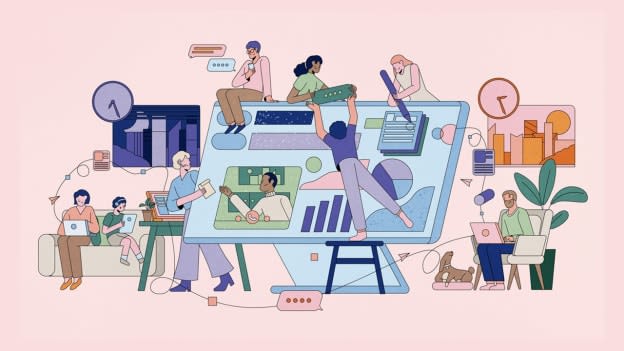Leadership learning for the hybrid era – Lessons from action learning
Get Set Learn Read similar articles

The world of work has changed. Companies are navigating new business terrains and workplace models. In this new context, there’s a need to reimagine learning. For far too long, executive leadership programs were skewed towards classroom sessions. But that may not be true in the future. As companies navigate a hybrid future, they need to develop their leaders even if they work remotely. In this article, we look at one such initiative in Equiniti India.
“Horizon 2.0”, a coaching initiative at Equiniti India was designed to align the SLDP (Skillsoft Leadership Development Program), with the goal of developing leaders as well as to realize better return on investment for learning. This program leveraged action learning methods to create a collaborative, team-driven learning approach throughout the employee lifecycle.
The action learning approach
“There is no action without learning & there is no learning without action," Professor Reginald Revans once said.
Action learning emphasizes the relationship between questioning and knowledge. And learning (L) is maximised if programmed knowledge (P) is combined with questioning (Q).
In the action learning formula, “L=P+Q”, questioning insight is more important than knowledge acquisition. This aligns with the fact that questioning is the base of any coaching; coaching is not about consulting, it is about questioning i.e. deepening thoughts through self-exploration and then applying the solutions to problems.
This process is initiated by sharing questions that can help get people started on the coaching path, such as:
- What are we trying to do?
- What is stopping us from doing it?
- What can we do about it?
Based on the response to these and more questions, learning coaches can then oversee the quality of team processes and learning through the use of effective communication, collective decision making, problem solving, and conflict management tools and techniques.
Why action learning for coaching?
Action learning was selected as the preferred technique for coaching and mentoring conversations due to the following advantages:
- Effectiveness: Action learning revolves around a problem to maximise the effectiveness of learning.
- Competency development: Participants enhance their competencies both in content knowledge (know how) and process skills (using various problem solving tools).
- Explicit and tacit knowledge: Participants learn both explicit and tacit knowledge that are required to solve problems.
- Specialization: Because of the team work element, participants also learn the various techniques for communication, decision making, problem solving, and conflict management as well as for leadership skills.
- Transformational: Action learning encourages questioning, reflection, and feedback to generate transformational learning and effective solutions in the problem solving process.
- Team based: Action learning projects are team-based and difficult to solve alone.
If one wants to truly reap its benefits of action learning, the baseline for success is to approach action learning as ‘team-work’.
The stakeholders
The mentoring program was designed to share experiences, and encourage scenario-based learning. It involved four key participants:
- Executives participate in the process by sharing their team related problems.
- Learning coaches i.e. heads of business functions who would challenge the leadership skills of executives and act as their mentors or coaches. They were asked to go through at least 2 channels from the 3 SLDP modules i.e. leading the team, leading people, and leading yourself.
- L&D team as the process owners and program managers.
- Digital academy that helps build core competencies and enables skill upliftment through content creation.
The basic idea was to ask people to bring up their problems and solve them through mentoring/coaching & SLDP.
Insights from Equiniti’s approach
The idea of Equiniti’s extensive coaching/mentoring program was to “Go beyond the horizon”, and enable participants to choose any two channels competency buckets from the three defined competency modules ones i.e. ‘Leading the business’, ‘Leading yourself’ and ‘Leading your team’. The team defined a well-outlined approach to achieve the learning outcomes it had set out with. Here’s how:
- Identify executives from the team and form teams with a team size of 5-6.
- Arrive at a minimum of two problem statements or activities which should demand the skills that executives should improve on in the learning journey.
- Explore three subjects and different channels in them along with the executives, choosing a minimum of four channels.
- Complete the problem solving and decision making videos. The idea here is to first complete viewing the videos, and then follow up with actual conversations.
- L&D to report to the learning coach or a ‘Head of the department’ on the completion status.
- Learning coach to meet the executives every fortnight to evaluate the progress on the actions. This is an extensive evaluation of executives’ competencies, questioning, reflection, feedback and learning objectives.
- Final review and certification
This detailed process helped Equiniti track and monitor the progress of learners, while giving them clear direction of where they were headed, thereby engaging the learners on an ongoing basis.
The Equiniti coaching-mentoring framework is drawn from a methodical approach. Simple design, compelling environment and focus implementation were the key to making learning actually happen and stick. Most importantly, the close involvement of senior stakeholders such as business and functional heads helped draw ownership and accountability. While L&D was running the process, an ongoing buy-in from senior leaders was critical to success.
(This article is curated by Rhucha Kulkarni based on a presentation by Manikandan PK. )






